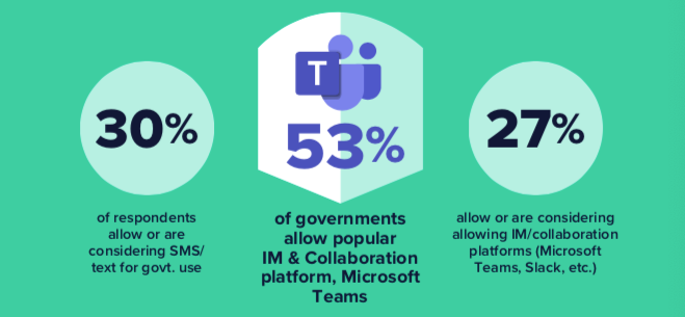Are Government Agencies Set Up for Evolving Communications in Public Records Requests?
In a recently published research brief, government records management roles across local, state and federal levels were surveyed about how they are handling evolving electronic communication technologies. Modern messaging data has become more complex and expansive, and it has impacted how governments handle FOIA and public records requests.
Survey results showed a lack of confidence among many agencies in their ability to fulfill records requests that include SMS/text and instant messaging data sent over mobile devices and through popular collaboration platforms like Microsoft Teams and Slack.

Enabling government employees with modern collaboration tools
Despite how many agencies lack confidence in their ability to include SMS/text and instant messages when responding to public records requests, they still recognize that employees have strong preferences for modern and popular communication tools and are enabling those methods of collaboration for their staff.
According to Robert Cruz, VP, Information Governance at Smarsh, "Changing demographics are going to force organizations into making a choice of either supporting modern communication tools or potentially losing that employee or losing the interest of that constituent as they request service."

Efficient retention of communications for records requests
All business-related electronic messages sent from government-issued accounts and devices—as well as those sent from privately owned devices—are considered public records and must be captured and archived.
As communication tools evolve, so too must data retrieval and retention methods. Modern channels are inundating governments with communications data that existing public records systems can’t handle. Many agencies haven’t modernized their processes for archiving newer and more complex content types and, ultimately, to effectively retrieve complete sets of data upon request.
Government agencies that don’t have a unified retention solution for electronic records management face gaps in record response practices and open the possibility of heavy drains of resources like fines and litigation.
"If you're going to allow communications through a specific channel, you have to be able to reliably capture it."
Governments need the right technology and policies to handle all electronic message types
Using a central solution, organizations can retain, retrieve and quickly review all channels of communication in one seamless archive. Electronic records management can be more efficient when all content is captured in native context and rapidly searchable by user, channel or keyword. This eliminates the need for disparate silo searches of a variety of archives or hard drives that would have required effort from different departments (such as IT, HR or users themselves).
While searching for the right technology partner to archive content, government agencies should also implement use policies to align with their records management strategy. Policies must include:
- Which platforms and specific applications are allowed for employees to use for internal and external communications; define allowed and prohibited channels and clearly outline how content will be captured and archived for public records management.
- Which types of devices are allowed; for example, corporate-issued devices only or personal devices including phones and tablets?
- An overview of how security assessments will be carried out, and what will happen if prohibition or use policies are violated. It’s important to be transparent about protocols regarding the capture and handling of electronic communications.
Read more in the research brief, “The State of Electronic Communications in Government,” to gain insight on communication tools and how you can improve your records management practice. Download the infographic here.
Share this post!
Smarsh Blog
Our internal subject matter experts and our network of external industry experts are featured with insights into the technology and industry trends that affect your electronic communications compliance initiatives. Sign up to benefit from their deep understanding, tips and best practices regarding how your company can manage compliance risk while unlocking the business value of your communications data.
Ready to enable compliant productivity?
Join the 6,500+ customers using Smarsh to drive their business forward.




Subscribe to the Smarsh Blog Digest
Subscribe to receive a monthly digest of articles exploring regulatory updates, news, trends and best practices in electronic communications capture and archiving.
Smarsh handles information you submit to Smarsh in accordance with its Privacy Policy. By clicking "submit", you consent to Smarsh processing your information and storing it in accordance with the Privacy Policy and agree to receive communications from Smarsh and its third-party partners regarding products and services that may be of interest to you. You may withdraw your consent at any time by emailing privacy@smarsh.com.
FOLLOW US